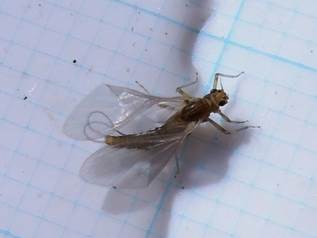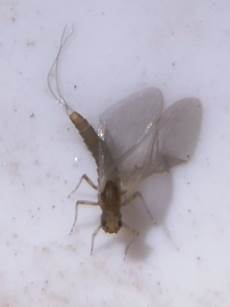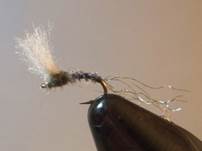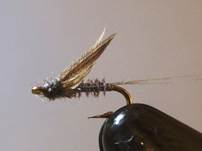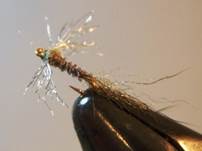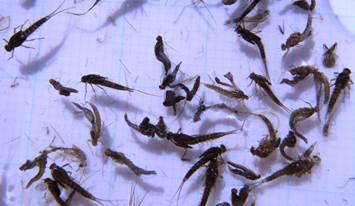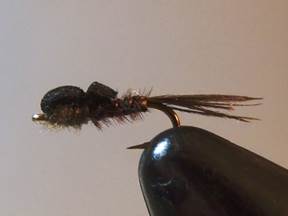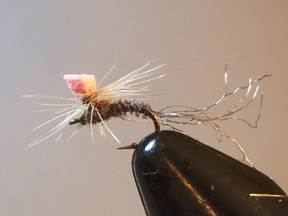PRESENTATION OR FLY PATTERN?
I never intend to conclude or to solve this age old discussion: which is more important; fly presentation or fly pattern? Rather, I hope this short article will remind each reader what he/she thinks about it and discuss within. In my case, I was reminded and made to think deeply about it through my experience of this fall with complicated hatches and selectively feeding trout. The stage is again at DePuy's Spring Creek in Livingston, MT (www.depuyspringcreek.com). Last year at this time, I experienced everything from super hatches to really complicated situations during Fall Baetis hatch at DePuy's (which was published here as "BWO – Happy Hours, Waterloo, & Solution). So this fall, I presumed I am slightly advanced from where I was then, in terms of skills and knowledge, and probably I am. However, creek and its residents (trout and insects) had new homework ready for me. I'm not sure if my answer is ready for evaluation but life goes on and creek keeps running. At least I know I have gained something and have stepped onto a higher level of spring-creek fishing and understanding trout and the insects there.
The Creek in the Fall:
Many anglers have their own favorite hatch and season. In my case, it's the Fall Baetis. I really consider the Fall Baetis hatch is the most challenging and technical event of the year, especially when I'm at DePuy's. It's not only due to the character of creek, but the season also contributes to the challenge. By late October trout around here are very much fed up for the year. They are not feeding in order to gain any more. Rather, trout continue to feed just to maintain their weight and condition for spawning and wintering. As both air and water temperature are going down the trout's metabolism is also going down, which translates to a lower appetite. Also, trout in most streams have seen all kinds of fly patterns, presentation methods, and brands of wading shoes around them due to the summer angling traffic. Furthermore, water levels get significantly lower than summer months, and the trout develop increased wariness as they lose cover and they can sense the presence of anglers. (NOTE: spring-fed flow doesn't fluctuate much but as the fall progresses, aquatic weeds start to die down. Consequently the water column drops) Trout will still rise to feed when the Fall Baetis hatch is decent, but in order to have them eat our flies, we have to show every skill and fly pattern we possess!!
The Insect in Question:
In SW Montana, when one refers "Baetis", it tends to include pretty much every species of "Family Baetidae". That's because most of them look similar for our fishing and fly-tying purposes. Then, as you know, we often call Baetis Blue-Winged-Olives. So Fall Baetis or Fall BWO have a distinctive dark-olive body in this area, and most of them range in size 20 and 22 plus an occasional size 24. However, from what I experienced and observed this fall, I hesitate to use Blue-Winged-Olive as they were definitely NOT olive (that's why I'm using Latin with Italic through this writing, which is more than I prefer). I'm sure they are one of "Genus Baetis" within "Family Baetidae" but they are definitely different from what we typically see and expect in terms of colors and sizes. They are Gray, or Light Gray, sometimes even Light Olive, and the majority of them are size 24 (plus some mix of 22). I'm seeking the taxonomical identification of this mayfly from entomologist and I do not yet have a definite identification. But pursuing this matter is beyond the purpose of this article, but I will report the results when I have a concrete identification.
|
|
Measurement of the tray is 1mm. |
It is NOT dark-olive………. |
The Roster of Flies:
Even when I tie typical dark-olive Baetis patterns, I mix up a couple of different shades such as gray and light olive. Also, though not many, I keep some size 24 patterns with me. So I wasn't totally unprepared. However, I repeated my "fish, return home and tie new flies" routine. Within the first few days of fishing I figured out some more effective patterns and stocked up my boxes accordingly. Here are my rosters.
|
|
|
CDC Sparkle Dun – TB Body Hook: Standard or Emerger #22 & #24 |
Yamamoto's No Hackle Gnat Hook: Straight-eye #22 & #24 |
Yamamoto's Spent Dun SSS Hook: Straight-eye #22 & #24 |
This one is a very effective pattern when used alone, but it also this serves as a pilot fly when trailing less visible dry-flies or subsurface patterns. |
Silhouette and color of this pattern actually represent several small mayfly species that appear at DePuy's any time of year. Hatch may not be significant but when we observe trout rising on something, this can be it. |
I have seined mayflies almost leaving their nymph shucks many times. Considering color and character, snowshoe rabbit feet was my choice for the shuck. Tied with sparse amount of synthetic fibers, spent wing will shape itself very realistically and naturally when it gets wet. This is one of a few patterns that look more realistic and practical on the water than on the vise. |
So Its Flies:
From early October the hatch was decent at many spots of creek. As I indicated earlier I gained some confidence and assurance of my skill and fly selection during the first few days. Eventually the hatch became more localized. For the rest of the fall, I routinely fished "Annie's Run" (upper flat section). This section is the classic spring creek setting: smooth flowing, wide, deep, and an aquatic-weed covered bottomed. This run holds some of the largest resident trout for right reasons. The hatch was decent and trout were rising and sipping. But I just couldn't take them!! It became tougher and tougher as the days went by. I don't say that I was beaten completely and lost all my confidence. But this was when I thought about "Is this because of my presentation or fly patterns?" All I could do was to come back the next day and challenge again. I was still clueless though I was surrounded by hatching mayflies and rising trout while standing in the middle of Annie's Run. I even thought "There may be super tiny midges hatching that I can't see". However, help was given to me by a very unexpected way. After the cast and drift, I left my line-leader-flies unattended in the water and stared at the surface around me to see if I could find something. Suddenly I felt a tug. My rig must have gone through among risers and one hooked itself accidentally (for him) and fortunately (for me). I reeled in carefully because this would be my opportunity to pump its stomach.
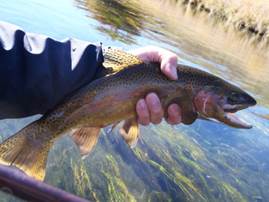 |
|
Too good to be caught by accident!! |
Now I see them…….. |
I was revived. Trout were feeding on ascending nymphs. That was why I couldn't take them on dry-flies and that was what made me think the trout would be taking super tiny invisible midges. So I dug into my boxes and found one pattern that would do the job for that afternoon. I was able to take a couple more "on purpose" (not by accident) till the hatch was over. That night, a more sophisticated version was born at my tying bench and it's been working well since.
|
Yamamoto's FA Nymph Hook: Straight-eye #22 & 24 |
FA stands for Floating & Ascending. It also implicates an attractive FA player who is wandering It's suggested to trail under a visible dun imitation. |
So I temporarily concluded "when working on the same trout with the same method of presentation, changing fly patterns makes a huge difference with my catching success".
Superior Presentation:
The nice weather continued. Insect hatches and trout action remained just as well. Although the whole situation was still challenging and confusing, I could manage to catch some trout and enjoy afternoons during the hatch. My own FA Nymph was a key-role. I would observe rise-rings: some rose with their noses sticking above the surface and others rose without breaking the surface. I aimed and made a perfect drag-free drift to one particular rise-ring. Trout came up and took my dry-fly!!
|
Foam Para Post Emerger Hook: Standard or Emerger #22 & 24 |
This sits very low and flat on water yet very visible and buoyant. One can choose favorite colors of foam posts. I personally use one color for one hook size for easy hook/fly size recognition, |
As always I brought it in carefully and pumped the stomach for contents. I was expecting to see duns and emergers. Well, this one had been feeding heavily on ascending nymphs (sorry no pictures of trout and stomach contents). I was happy but slightly confused. When my dry-fly is making a perfect drift on the surface, my trailer fly (in this case, FA Nymph) should be drifting and flowing naturally slightly below the surface. My trailer fly should have been taken gladly. Why did that trout come up to take my dry-fly on surface all the way? This happened to me more than once when I was targeting subtle rises with which trout's noses were not sticking out of the surface. Did my presentation make my dry-flies look so natural? Is the perfect presentation superior to fly-selection? Does it induce strikes from trout that are feeding in different water columns?
|
Another example of subsurface riser/feeder that suddenly came up to take my dry-fly. |
Answer (Rather a Reminder) – Noticeability & Observation:
My plausible answer is: fly presentation and fly pattern are both equally important. Both are equally critical when fishing spring creeks. When one presentation method is not performing, change the angle of presentation. If a fly is not causing any strikes, change patterns (size, shape, & color) of the same category (e.g., within dry-flies or dun imitations) or change types (dry ßà emerger ßà nymph). The key abilities to make these changes happen are to NOTICE and to OBSERVE. In this case of mine, I first noticed that Baetis of this fall were somewhat different from the usual. I observed rise-rings and rise-forms of trout (including the over-thinking of tiny midges). I often changed my presentation and fly patterns at the same time. I often stopped casting to observe what was happening on the water and seined them.
When an angler spends a certain amount of time on their favorite stream one should learn from the water, the trout, and anything involved in the situation. The angler will gain knowledge and experience. Based on those, one will develop tactics for the day, the month, or the season. This angler will do fine and enjoy fishing as long as their tactics and ideas are working. But when something new or unexpected happens and the trout stop taking their flies, the angler's response will be either totally at a loss or willing to look for clues. When situation turns out to be "it's SUPPOSED TO BE so and so…….but", one can overcome the situation by noticing and observing their surroundings (water, insects, trout, and so forth). At least one should be willing to make an effort to conquer the situation by noticing and observing, rather than putting oneself in total chaos and frustration. The whole process will and should make you an angler with better understanding of the water and its residents (trout and insects).
Satoshi Yamamoto, https://leftyangler.blogspot.com, brought his passion for fly-fishing and fly-tying and became the first ever Japanese guide in Livingston, MT. He loves to float Mighty Yellowstone River and wander around Yellowstone Park waters. Perhaps he's only one guide in the area who can translate complicated mood of spring creeks and trout there in a couple of different languages. Satoshi is an accomplished fly-tyer as well. His innovative patterns, that cover many trout waters, can be seen at https://leftytyer.blogspot.com.
| Sysadmin Note |
|---|
| Part 2 can be found here |

